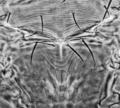Scirtothrips inermis
Recognition data
Distinguishing features
Both sexes fully winged. Body yellow, antecostal ridges on tergites and sternites dark; fore wings shaded near base but pale distally; antennal segment I pale, II–VIII darker. Head wider than long; ocellar region with several transverse lines, vertex closely striate; ocellar setae pair III about twice as long as diameter of one posterior ocellus, close together between midpoints of posterior ocelli. Pronotum with transverse striae rather widely spaced, distance between lines about equal to diameter of a discal setal pore; 4 pairs of posteromarginal setae, S2 long, 50 to 65 microns. Metanotal reticulation arched around anterior, almost equiangular on posterior half; median setae close to anterior margin. Forewing first vein setae with 3 setae distally; second vein with 2–3 setae; posteromarginal cilia straight. Abdominal tergites III–V median setae longer than distance between their bases; tergal microtrichial fields with 4–6 discal setae; tergite VIII with discal microtrichia anteromedially, posteromarginal comb complete; tergite IX without discal microtrichia. Sternites with microtrichial fields extending just mesad of marginal setae S2.
Male smaller than female; tergite IX without drepanae.
Related and similar species
Despite having been found in several parts of the world the relationships and biology of S. inermis remain unclear. It has rather longer ocellar setae than any other species considered here. The genus Scirtothrips currently includes 100 listed species from various parts of the world. Bailey (1964) provided keys to 13 from North America, but that work was based on specimens that were not fully cleared, and thus few structural details were available concerning differences between species. Similarly, Johansen & Mojica-Guzman (1999) provided keys to 33 species from Mexico, but doubts have been expressed concerning the biological reality of many of these (Mound & zur Strassen, 2001). Hoddle & Mound (2003) provided information on 21 Scirtothrips species from Australia, and Rugman-Jones et al. (2006) produced a molecular key to several pest species in this genus.
Taxonomic data
Current valid name
Scirtothrips inermis Priesner
Original name and synonyms
- Scirtothrips inermis Priesner, 1933: 186
Family placement
Thripidae, Thripinae
Biological data
Life history
Breeding on leaves
Host plants
Presumably polyphagous, including Viburnum (Caprifoliaceae), Gerbera (Asteraceae) and Citrus (Rutaceae).
Tospoviruses vectored
None
Crop damage
None
Distribution data
Area of origin
Not known
Distribution
Recorded widely but irregularly; Canary Islands, Sicily, California, New Zealand, South Australia.






